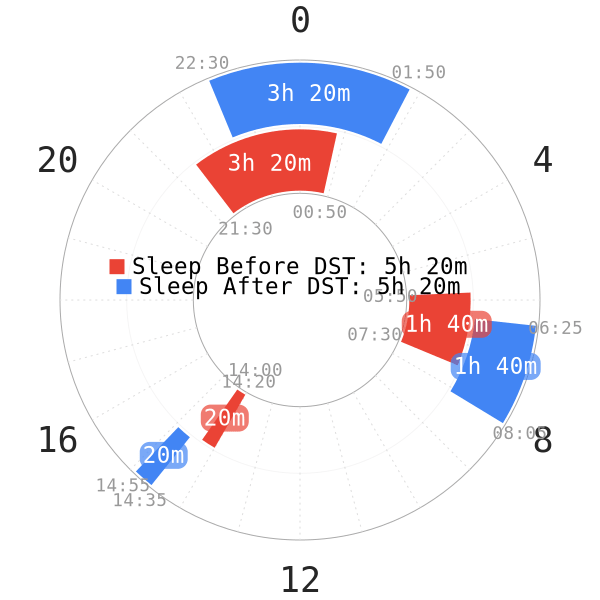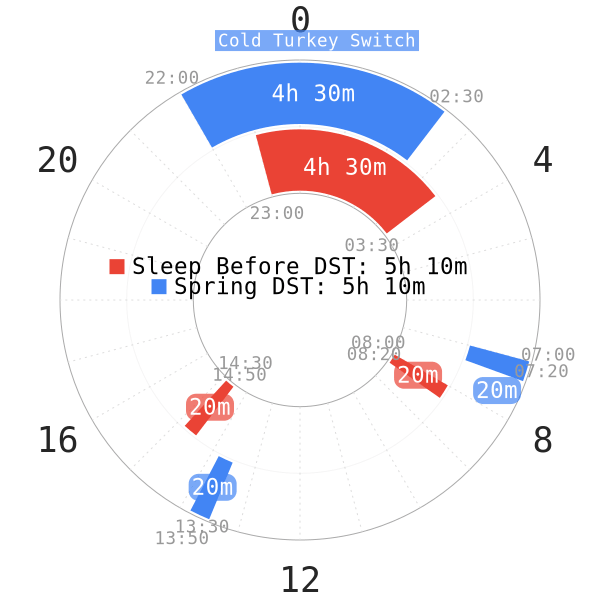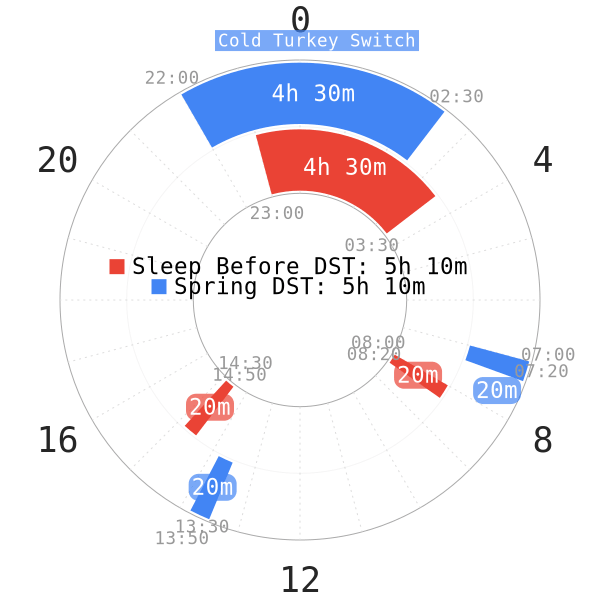Introduction
Daylight Saving Time, or DST, requires an annual 1-hour change in local sleep time1. Specifically, there are 2 DST instances each year:
- Spring (e.g, around March), with the clock moving forward 1 hour.
- Fall (e.g, October), with the clock moving backward 1 hour.
Depending on your location, DST may be 1 month later or earlier than March or October. Overall, DST has had a long history, albeit a politically controversial one2. Currently, around 70 countries in the world still adopt DST, most notably Europe and the US. There is however no DST usage in other continents such as Asia and Africa because of negligible differences in local sleep time over the year1.
This post will explore the effects that DST has on sleep in general, and polyphasic sleep in particular. Thus, we will also present the viable methods that we have documented over time to help cope with DST. Even though DST is not a direct social-intervening threat like travelling events, it is not within our control. Because only the governments have a say on the matter, DST can be quite a considerable social threat to your adaptations.
Content
- DST Effects on Sleep and Well-being
- Solutions for Polyphasic Sleepers
- Vulnerability Rating of Polyphasic Schedules
Effects of Daylight Saving Time on Sleep & Well-being
Ever since its creation, DST has reported many serious problems with health concerns and even posed life-threatening scenarios. This is in no way an exaggeration, so check out the list below:
- Increased sleep onset and interrupted sleep1
- Reduced sleep duration and sleep efficiency3
- Compromised overall sleep quality and the rest-activity cycles4
- Decreased vigilance and heightened daytime sleepiness in high school students5
- Increased traffic accident rate1
- More vulnerability to acute myocardial infarction, especially in the first week after the spring shift6
- Circadian misalignment and sleep deprivation6
While the list only covers some notable destructive effects of DST, it does show that DST can be a fearsome threat to well-being. Most monophasic sleepers, though, may not really be bothered by it. Because of their usually limitless flexibility (and potentially a bad one at that!), they for the most part can ignore DST soundly. Regardless, many of them have also express harsh dislike with the concept of DST.
For polyphasic sleepers, it is a totally different issue; many sleepers have complained about it, and for good reasons. In fact, DST is so obnoxious, that there have been petitions for its permanent abolition2. Because of the lingering effects of each DST switch and its hindering nature, we will list out some ways for you to prepare for them.
Solutions to Daylight Saving Time
While these solutions only help mitigate the damages on your polyphasic schedule, they may actually end up salvaging your entire adaptation. Each solution has their own pros and cons, so choose them wisely.
General Strategies
- In general, you should try to stick to all of your sleep times during the DST changeover.
- Sleep blocks should have same duration throughout.
- Sleep blocks near to or overlap the border may need some tweaks in their timing to alleviate excess sleep deprivation. However, most polyphasers do not find this a considerable issue.
- If the DST changeover is just after you start your schedule, you might want to start sleeping on the new time zone early to make sure the adaptation period keeps consistent scheduling. Otherwise, stay on the former scheduled time until adaptation begins.

- Note that you can still keep certain sleep blocks on your schedule at the original times even after the DST switch. This depends on your timetable availability and your own ability to adapt to a smaller wake periods.
- If you just started an adaptation, this can be an advantage for you to sort out your desired new sleep times. This also means you do not have to rotate your entire schedule by 1 hour back or forth.
- In the DC1 example above, only the first core moves forward by 1 hour. The second core and the nap only slightly move forward compared to the original sleep times.
- Alternatively, you can keep a certain core or nap on your schedule at the same sleep time as before the switch.
Important Alarm Notes!
- Autumn DST: Just set your alarm as the usual core duration. If your core is 3.5h long, you will still sleep 3.5h. However, technically you will feel like sleeping for 4.5h once the clock has moved back 1 hour.
- Spring DST: Same as autumn DST. If your core sleep is 4.5h long, for example, you will feel like you only slept 3.5h after the clock has moved forward 1 hour. However, this does not matter because time is just a representation of what happens in the world. The shift does not change anything if you know you sleep the correct sleep duration in real time.
- Set your alarm 5 minutes earlier than the usual scheduled time. This means you will wake up 5 minutes earlier than usual. This is because clocks may automatically move forward or backward 1 hour at the 59th minute or right at the next minute!
However, all of the above only count if you do not use your phones or any devices that get locally updated when DST begins. In the autumn DST, if DST strikes the middle of your core sleep, it means you oversleep by one hour. Locally updated phone(s) will move the real time back one hour during your sleep. As a result, the alarms will ring one hour later than your scheduled sleep time!
In the same vein, spring DST will mean that you undersleep by one hour. The clock moves forward one hour, which gives you one less hour in bed. Be careful when choosing your alarms to help you get the right sleep duration! If DST occurs when you are normally awake, then you have nothing to worry about.
Solution 1: Cold Turkey Rotation
For this method, you simply rotate your entire polyphasic schedule by 1 hour (either backward or forward) within one day. You just follow the local time on the clock and adjust your schedule accordingly. There is no looking back here and you can consider it done easily.

The advantages of this method are as follows:
- Fast change in sleep times. No need to worry for the next days.
- This works very well if your timetable does not have any limitations over your new sleep times. This is because many people find 1h switch quite a noticeable change that can clash with some of their commitments.
- In the Everyman 2 example above, you just move your core or your entire schedule 1h earlier than usual, before DST takes effect. This way, when spring DST occurs, your E2 core will shift back to the original time. It means you will still always be sleeping at 11 PM for the core.
- You can do the same with the autumn DST.
The disadvantages, on the other hand, are:
- This sudden switch will set your adaptation progress back several days potentially. Several days because the aforementioned studies do show that DST effects can linger for up to one week. Furthermore, adapting polyphasic sleepers do report this effect to last for even several weeks if DST happens in Stage 3.
- You will experience more grogginess and oversleeping chances.
Solution 2: Gradual Rotation
Warning! This method has been shown to be ineffective and you are encouraged to avoid it at all cost!
Similar to the gradual adaptation method, you make incremental switches from day today (e.g, 10m per day). You do this until you have reached the new sleep time.
Advantages:
- Since the switch is small, this may not set you back much, or at all. On schedules with higher total sleep, this process is even more forgiving than more extreme schedules.
- Your productivity levels are likely the same as your normal baseline with no DST switch.
Disadvantages:
- Drags out adaptation because it takes a long time and precise planning to complete.
- Requires that your timetable can afford this gradual switch. Thus, if your work schedule is unpredictable, this method likely will fall apart quickly. In addition, the longer you do a task the more likely you are going to make some kind of mistakes.
Most importantly, the community also has some data on polyphasic sleepers trying the gradual method. With at least 15 participants in the Discord platform, we conducted an experiment on how gradual adaptation to DST change would affect their sleep schedule. Without a surprise, a big majority (13) felt very lethargic during and even after the attempt.
Considering all necessary elements, you should make a full switch to the new sleep time cold turkey. Some people have reported grogginess and malaise from a gradual, slow transition with a couple minutes from day to day.
Solution 3: Stick to your original schedule
For this method, you basically ignore DST’s existence. You just sleep at your normal sleep time like nothing has ever happened. If your core sleep is at 10 PM, you still sleep at 10 PM on the night of the switch, etc. However, from this night on, it will become either 9 PM or 11 PM.

Advantages:
- There is no adaptation setback because you are still adhering to your sleep times. This includes your core(s) and nap(s).
- Eases falling asleep. If your adaptation progresses further, you should be able to fall asleep easily at these original sleep times.
- If you are an experienced polyphasic sleeper, you can move your sleep(s) back or forward 1h with ease, especially after adaptation. This is because your body can detect the pattern of tiredness on the schedule to give appropriate sleep cues.
Disadvantages:
- You need a timetable that allows you to stick with the original sleep times. This is because after the switch, you are naturally settling down on a new sleep time. The previous midnight as start time now will become either 1 AM or 11 PM.
- The 1h change on the clock can still confuse and decrease sleep quality. Similar to other methods, it can still take at least some days or longer to bounce back.
Vulnerability rating of polyphasic schedules
Because of how dangerous DST is, we present a full list of all 25 polyphasic schedules and how they fare against DST.
Note:
- We assume sleepers (including short sleepers) are adapting to these schedules.
- Additionally, the table does not account for extended schedule versions and only standard scheduling.
- Vulnerability factors in adaptation difficulty (e.g, total sleep time) and whether DST change hits any sleep blocks on the schedule.
Ratings:
- 4/4: Basically immune to DST effects
- 3/4: Neutral, can somewhat handle DST
- 2/4: Rather vulnerable, but can mitigate little damage
- 1/4: Highly vulnerable to DST, can break down easily
| Polyphasic Schedule Groups | Schedules | Vulnerability Rating |
| Biphasic | E1 | |
| Siesta | ||
| Segmented | ||
| Biphasic-X | ||
| Everyman | E2 | |
| E3 | ||
| E4 | ||
| E5 | ||
| SEVAMAYL | ||
| Trimaxion | ||
| Dual Core | DC1 | |
| DC2 | ||
| DC3 | ||
| DC4 | ||
| DUCAMAYL | ||
| Bimaxion | ||
| Tri Core | Triphasic | |
| TC1 | ||
| TC2 | ||
| Core-only | QC0 | |
| CAMAYL | ||
| Nap-only | Uberman | |
| Dymaxion | ||
| SPAMAYL | ||
| Tesla |
Brief analysis
- All schedules with a core sleep spanning across the graveyard hours (~midnight to 8 AM) take direct hits from DST switch. This is because the switch (usually around ~1-3 AM range) happens right in the middle of the core sleep.
- Extended schedules with a higher total sleep have a generally easier adaptation, can absorb the hit and recover faster than more extreme schedules. Thus, Biphasic schedules are overall pretty resilient. Non-reducing variants can even shrug off DST.
- Minimum-sleep-threshold schedules (4h TST) generally have a hard time with DST, whether it interrupts the core sleep or not.
- Flexible “-AMAYL” schedules often can neutralize DST quite easily. Their adaptations are difficult, but their flexibility mechanics allow them to dodge DST naturally. Since the assumption is a short sleeper adapting to SPAMAYL, they can handle DST effortlessly on this schedule as well. SEVAMAYL only has 1 core sleep and its core is often long enough for DST to cut into; thus, it is somewhat vulnerable to DST.
- Dual Core schedules, whose TST is higher than Everyman schedules, may have an easier DST switch. This is because DST often occurs in the middle of the wake gap between two cores.
- Short sleepers, despite the genetic advantage, may still struggle with radical schedules just as much as average sleepers on milder schedules with DST. Thus, the inflexible nap-only schedules like Uberman and Dymaxion can pose serious DST problems.
Main author: Crimson & GeneralNguyen
Page last updated: 15 February 2021
Reference
- Harrison, Y. (2013). The impact of daylight saving time on sleep and related behaviours. Sleep Medicine Reviews, 17(4), 285–292. doi:10.1016/j.smrv.2012.10.001
- Roenneberg, Till, et al. “Why should we abolish daylight saving time?.” Journal of biological rhythms 34.3 (2019): 227-230.
- Lahti, T. A., Leppämäki, S., Lönnqvist, J., & Partonen, T. (2006). Transition to daylight saving time reduces sleep duration plus sleep efficiency of the deprived sleep. Neuroscience Letters, 406(3), 174–177. doi:10.1016/j.neulet.2006.07.024
- Lahti, T. A., Leppämäki, S., Lönnqvist, J., & Partonen, T. (2008). Transitions into and out of daylight saving time compromise sleep and the rest-activity cycles. BMC Physiology, 8(1), 3. doi:10.1186/1472-6793-8-3
- Medina, D., Ebben, M., Milrad, S., Atkinson, B., & Krieger, A. C. (2015). Adverse Effects of Daylight Saving Time on Adolescents’ Sleep and Vigilance. Journal of Clinical Sleep Medicine, 11(08), 879–884. doi:10.5664/jcsm.4938
- Manfredini, R., Fabbian, F., Cappadona, R., & Modesti, P. A. (2018). Daylight saving time, circadian rhythms, and cardiovascular health. Internal and Emergency Medicine, 13(5), 641–646. doi:10.1007/s11739-018-1900-4
